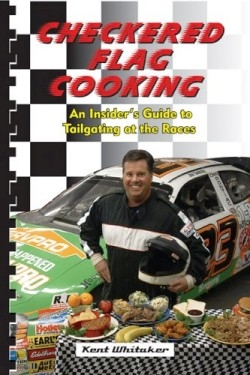Checkered Flag Cooking
An Insider&8217;s Guide to Tailgating at the Races
Deep-fried Twinkies. Yes, deep-fried Twinkies. That’s just one of the more, um, exotic recipes that can be found in this book.
While ostensibly a cookbook, this ring-bound volume is actually a celebration of the culture that has evolved around car racing in the United States, of which food is an important aspect. In addition to recipes, the author includes profiles of drivers, crewmembers, and food vendors. While the NASCAR circuit is represented, more emphasis is placed on the “minor leagues” of racing. Whitaker includes favorite recipes and comments from drivers, crewmembers, and race fans (and he is clearly a fan).
The common denominator of the more than 300 recipes gathered here is ease of preparation, an absolute necessity when cooking on a camp stove or eating out of a cooler. Too often, however, the desire for ease translates into building recipes out of bottled salsas or cream of mushroom soup, or techniques like that used in the Zip Close Messy Omelet, where all the ingredients are sealed in a plastic bag and cooked in boiling water, a technique better suited for cities under siege than a social gathering of friends and family.
But Whitaker realizes that great food doesn’t have to be difficult. Shrimp and Grits is a classic (and easy—two pans, twenty minutes) dish from the low country of South Carolina. Homestead Cuban Sandwich requires “no cleanup” and depends upon good ingredients for its fabulous flavor. The recipe for Memphis Style Dry Rub Pork Ribs correctly identifies hickory wood chips as a required ingredient (although no two chefs will ever agree on the proper ingredients and measures for the rub).
Whitaker, who often goes by the nickname “The Deck Chef,” is the author of Smoke in the Mountains Cookbook: The Art of Appalachian Barbecue; his Famous Barbecue Cornbread recipe won the 2003 Emeril Live Food Network Barbecue Contest. He is currently preparing his own cooking show for the local PBS station in Chattanooga, TN.
Aware of his intended audience, Whitaker maintains a casual, folksy tone in his writing throughout the book. He has a penchant, though, for the imprecise and vague turn of phrase. His prose is littered with expressions like “The great thing about auto racing …” and “One thing I noticed when talking …” Two recipes on the same page begin with phrases calling them “neat.” Exclamation marks are liberally applied, often three or four per page.
Readers who fancy themselves gourmets will probably snub this book, which would really be their loss, because there are certainly some very tasty dishes to be found within its covers. Just avoid anything boiled and eaten out of a zip-close plastic bag.
Reviewed by
Erik Bledsoe
Disclosure: This article is not an endorsement, but a review. The publisher of this book provided free copies of the book to have their book reviewed by a professional reviewer. No fee was paid by the publisher for this review. Foreword Reviews only recommends books that we love. Foreword Magazine, Inc. is disclosing this in accordance with the Federal Trade Commission’s 16 CFR, Part 255.

